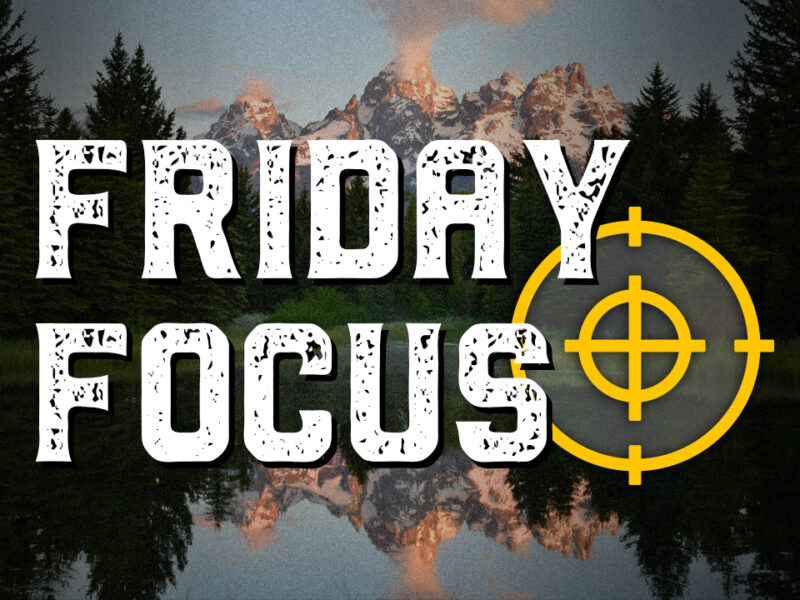“Begin to Heal”: Eastern Shoshone Member Leads Bison Restoration Effort
Bringing back the buffalo is key to health, education and culture for tribal communities in Wyoming
- Published In: Other News & Features
- Last Updated: Jan 13, 2023

By Kristi Eaton
Special to the Wyoming Truth
At age 17, Jason Baldes took a trip to East Africa with his father that changed his life: On a 100-mile drive, he witnessed the wildebeest migration for as far as his eye could see—including 30 other species and predators in every direction—and was reminded of the 30 to 60 million buffalo that roamed North America less than 200 years ago.
Baldes, a member of the Eastern Shoshone Tribe, returned to his home in Wyoming and resolved to dedicate his life to restoring buffalo to their native land.
Today, Baldes, 44, is the Tribal Buffalo Senior Program Manager at the National Wildlife Federation. He also leads the Wind River Tribal Buffalo Initiative, where he raises money for land acquisition to support the restoration ($8.5M to date) and facilitates the cultural, spiritual and ecological reconnection between tribal youth and buffalo.

Baldes’ focus is conservation buffalo, which do not contain the genes of cattle. He develops national policy and legislation, as well as collaborates with other tribal buffalo programs.
While bison hold great significance in tribal communities, they also are central to the story of America, said Baldes, who lives near the Shoshone Tribe’s pasture with his wife, daughter and two grandchildren. He holds undergraduate and graduate degrees in land resources and environmental sciences from Montana State University, where he concentrated on tribal buffalo restoration.
The Wyoming Truth recently caught up with Baldes to discuss his work. What follows are excerpts from the interview.
What led you to create the Wind River Tribal Buffalo Initiative?
Baldes: Well, the initiative is fairly new, but the work has been going on for some time. I work for the tribal Partnerships Program with the National Wildlife Federation as the tribal buffalo Senior Program Manager. And in that capacity, I have built resolution-based agreements with both tribes to build buffalo programs collaboratively and simultaneously. That resolution [with] the Shawnee tribe happened back in 2013 or so.
Where does the herd stand now?
Baldes: Each tribe has their own herd. The Northern Arapaho have 56 and Eastern Shoshone 79. And so they’re both located nearby one another, kind of north of Johnstown near Kinnear.
How are you reconnecting tribal youth with the buffalo?
Baldes: So this past year, we had over 800 tribal youth out to see the buffalo herds. The schools on the reservation, specifically, understand the cultural importance of a buffalo to our people. We depended at one time on that animal for sustenance. And it was central to our belief systems and values ceremony. . . . .
When we bring schools out, we usually have a sit-down with the buffalo. We get amongst them, and then talk about the importance in history, culture, language, and then we usually do an activity . . . around a cultural connection. For instance, the buffalo horn…in our languages, it was a living object. And historically, we each would have had our own buffalo spoon; it was a utensil. So we would have carried that around, it would have been designed with our family effigies or our societies or clans . . . . Of course, our lodges, our clothing, everything was utilized from the animal . . .
Reconnecting to that animal means learning about how we did that [and] also understanding the nutritional importance of buffalo. We have the highest rates of diabetes and heart disease and other health-related issues that [are] directly attributable from the removal of buffalo from our diet. So as we begin to heal, it happens by eating better; it happens by eating traditional foods. Getting buffalo back is as much about cultural and ecological restoration as it is about our own healing. . . .
You hope to increase the herd to 1,000, correct?
Baldes: Well, what we have here is conservation buffalo. So these are animals that have the reputable genetics; they [are] certified disease-free . . . conservation buffalo because they have the genetics of Yellowstone. Most of the buffalo [in] the United States today have cattle gene introgression. And so because these animals are conservation buffalo makes them very important in the conservation of the species itself.
Why is that important?
Baldes: It’s very important that conservation of the genetics is considered in restoring this animal, because there [are] 300,000 buffalo out there in the commercial meat market that have cattle gene introgression. There’s less than 25,000 conservation buffalo. And it’s very important that we put emphasis on ensuring that this species can exist as [it] was intended. . . . as an ecosystem engineer . . .in large numbers on large landscapes to effectively make ecological change. That’s climate mitigation. That’s carbon storage. That’s food sovereignty for us as tribal people. So it’s very important that we restore this animal to a level that it can really heal the land.
Are there any obstacles to this endeavor?
Baldes: The main obstacle I face is really a paradigm. And the tribes and Indigenous people have a paradigm that’s more often associated with the ecology, the interconnectedness, the interrelatedness of organisms, predators, like wolves and bears and buffalo. And the dominant society has a paradigm that’s more focused on the economy. As we think about changing land use or prioritizing buffalo on the landscape, we have to challenge our worldview, that buffalo restoration is . . . more holistic. Not only what it does for the land, but what it does for our people and reconciling some of the past.













